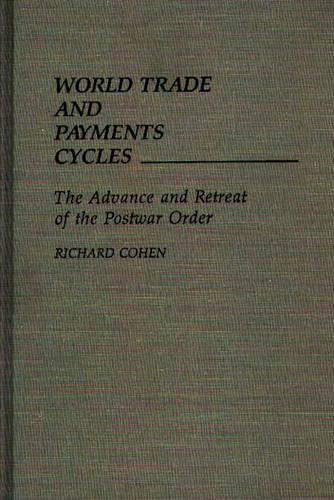
World Trade and Payments Cycles: The Advance and Retreat of the Postwar Order
(Hardback)
Publishing Details
World Trade and Payments Cycles: The Advance and Retreat of the Postwar Order
By (Author) Richard Cohen
Bloomsbury Publishing PLC
Praeger Publishers Inc
3rd November 1989
United States
Classifications
Tertiary Education
Non Fiction
General and world history
380.109
Physical Properties
Hardback
322
Description
This landmark study of economic history since World War II systematically explores why postwar trade and payments have evolved as they have, the prospects for their future evolution, and the range of policy adjustments likely to be required. Through a rigorous examination and analysis of historical records, the author makes two significant and unique contributions to the scholarship on the subject. First, he reveals the existence of distinct cycles in world trade and payments, beginning in 1959. While scholars have recognized postwar business cycles, none have identified--until now--trade and payments cycles which seem to run parallel. Second, Cohen utilizes newly researched data to explore the much-heralded J-curve and its relevance in relating exchange rates to trade balances, and he identifies several important factors which have slowed the maturation of the J-curve effect on U.S. balances. The study is divided into four parts and begins by looking at the forces that have shaped the postwar trade and payments order. Cohen then turns to an investigation of the period of advance in the trade and payments order from 1945-1967, describing three distinct stages that reflect the emergence, the establishment, and the peak of this period. Section three begins with an analysis of the structure and causes of the four postwar trade and payments cycles and includes an examination of the differences among them. Subsequent chapters address the different cycles themselves, reviewing the history of each and evaluating the growing challenges to the postwar trade and payments order. In the concluding section, Cohen explores why the J-curve in the U.S. has been so weak during the current cycle and assesses the likely consequences of the failure of existing policies to reduce external imbalances. Finally, the author offers a set of recommendations to reduce such imbalances through a new Cycle of Adjustment. Students of economic history, policy makers, and investors will find in Cohen's work significant new insights into economic processes and the probable future economic terrain.
Reviews
"The author has made an important contribution in establishing a rather unique method of analyzing the post-war world economy from the aspect of World Trade and Payments cycles and making an intriguing comparison in the various phases of the current and past trade cycles."-Keisuke Egashira President Seibu Saison International Limited
Cohen examines in minute detail selected statistical index of international trade activity from WW II to the present. For purposes of analysis, the time span of 40-plus years is divided into six periods of varying length and characterization: 1945-51, economic reconstruction; 1952-58, transition in trade and payments; 1959-67, rapid growth in internation trade; 1968-75, inflationary growth in world trade; 1976-82, stagflation; and 1983-86, disinflation. From the arcane data, the author discovers six distinct phase cycles emerging since 1959 in world trade and payments, which are driven by the combined influences of three factors: primary input costs, the macroeconomic and international payments policies of developed countries, and differences among developed countries' macroeconomic policies. He further discerns long-term trends in world trade and payments that overlap trade and payments cycles. Insights the author perceives from those patterns provide a basis for his prescriptions for policy actions leading to future increases in world productivity and trade. Appropriate for upper-division under-graduate and graduate collections.-Choice
"Cohen examines in minute detail selected statistical index of international trade activity from WW II to the present. For purposes of analysis, the time span of 40-plus years is divided into six periods of varying length and characterization: 1945-51, economic reconstruction; 1952-58, transition in trade and payments; 1959-67, rapid growth in internation trade; 1968-75, inflationary growth in world trade; 1976-82, stagflation; and 1983-86, disinflation. From the arcane data, the author discovers six distinct phase cycles emerging since 1959 in world trade and payments, which are driven by the combined influences of three factors: primary input costs, the macroeconomic and international payments policies of developed countries, and differences among developed countries' macroeconomic policies. He further discerns long-term trends in world trade and payments that overlap trade and payments cycles. Insights the author perceives from those patterns provide a basis for his prescriptions for policy actions leading to future increases in world productivity and trade. Appropriate for upper-division under-graduate and graduate collections."-Choice
Author Bio
RICHARD COHEN directs his own consulting firm, Washington/World Analysts, and writes a monthly review and forecast of U.S. economic developments. He is coauthor (with Norman Bailey )of The Mexican Time Bomb.
